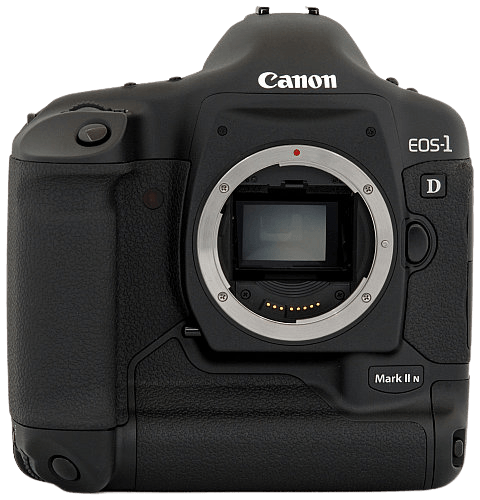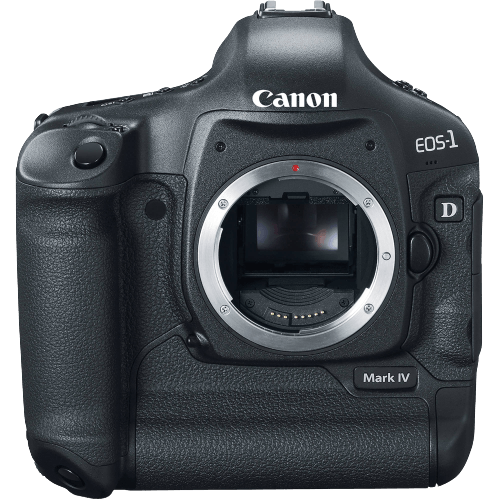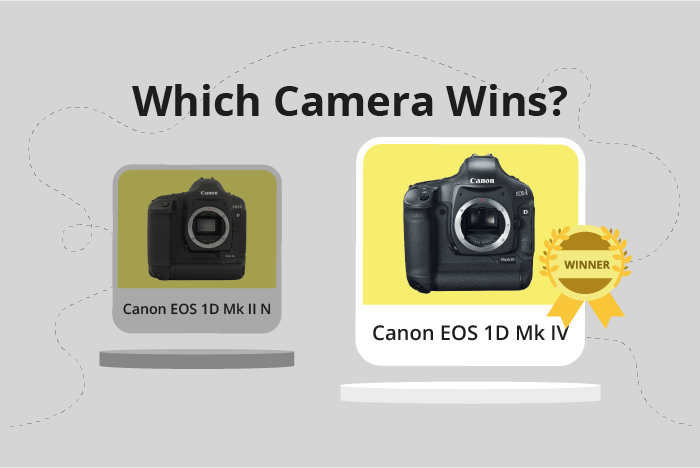Canon EOS 1D Mark II N vs EOS 1D Mark IV Comparison
Canon EOS 1D Mark II N

Canon EOS 1D Mark IV

The Canon EOS 1D Mark IV outperforms the Canon EOS 1D Mark II N with a score of 54/100 compared to 40/100. Both cameras are DSLRs, announced in 2009 and 2005 respectively. They share similar dimensions, with the Mark IV being slightly lighter at 1230g compared to the Mark II N’s 1565g.
The Mark IV has a higher score due to its better specifications, making it a more advanced camera. However, the Mark II N has its advantages as well, such as a lower launch price of $5986 compared to the Mark IV’s $5840.
Taking all these factors into consideration, the Canon EOS 1D Mark IV is a better camera than the Canon EOS 1D Mark II N, but the latter may be more suitable for those on a budget.
Canon EOS 1D Mark II N vs 1D Mark IV Overview and Optics
The Canon EOS 1D Mark IV outperforms the Canon EOS 1D Mark II N in optics with a score of 54/100 compared to 46/100. Both cameras share common specifications, such as CMOS sensor type, APS-H sensor size, Canon EF lens mount, and lack of image stabilization.
The 1D Mark IV excels with its higher megapixel count of 16.1, providing better image resolution than the 1D Mark II N’s 8.2 megapixels. Additionally, the 1D Mark IV has a faster shooting speed of 10 frames per second (fps), allowing for improved action and sports photography compared to the 1D Mark II N’s 8.5 fps. The 1D Mark IV also boasts a superior DXOMARK sensor score of 74, indicating better overall image quality and performance.
On the other hand, the 1D Mark II N does not have any specific advantages in optics over the 1D Mark IV. It has a lower megapixel count, slower shooting speed, and lower DXOMARK sensor score.
Taking these points into consideration, it is clear that the Canon EOS 1D Mark IV offers superior optics compared to the Canon EOS 1D Mark II N. With its higher megapixel count, faster shooting speed, and better DXOMARK sensor score, the 1D Mark IV is the better choice for photographers seeking improved image quality and performance. The 1D Mark II N, while still a capable camera, falls short in the optics department in comparison to its successor.
Canon EOS 1D Mark II N vs 1D Mark IV Video Performance
When examining the video capabilities of the Canon EOS 1D Mark II N and the Canon EOS 1D Mark IV, it is important to note that the Canon EOS 1D Mark II N does not have any video functionality. Therefore, this comparison will focus on the video features of the Canon EOS 1D Mark IV.
The Canon EOS 1D Mark IV has a video score of 43 out of 100. It offers Full HD video recording with a maximum resolution of 1920 x 1080 pixels. The camera is capable of recording video at a maximum frame rate of 30 frames per second. However, it does not have built-in time-lapse functionality.
Taking these factors into consideration, the Canon EOS 1D Mark IV provides decent video capabilities for users who require this feature in their camera. On the other hand, the Canon EOS 1D Mark II N lacks video functionality altogether, making it unsuitable for those who need video recording capabilities in their photography equipment.
Canon EOS 1D Mark II N vs 1D Mark IV Features and Benefits
The Canon EOS 1D Mark IV outperforms the Canon EOS 1D Mark II N with a feature score of 54/100 compared to 17/100. Despite these differences, both cameras share some specifications. Neither camera has a touchscreen, flip screen, GPS, WIFI, or bluetooth.
The Canon EOS 1D Mark IV excels with its 3-inch screen size and 920,000-dot screen resolution, providing a larger and clearer display for users compared to the Canon EOS 1D Mark II N’s 2.5-inch screen and 230,000-dot resolution. This advantage allows for better image review and composition, enhancing the overall user experience.
On the other hand, the Canon EOS 1D Mark II N does not offer any notable advantages over the Canon EOS 1D Mark IV in terms of features. The lack of improvements in this model makes it a less competitive option compared to the Mark IV.
Taking these points into consideration, it is clear that the Canon EOS 1D Mark IV is a superior camera in terms of features. The larger screen size and higher screen resolution significantly enhance the user experience, making it a better choice for photographers. In contrast, the Canon EOS 1D Mark II N falls short in offering any advantages over the Mark IV, making it a less desirable option.
Canon EOS 1D Mark II N vs EOS 1D Mark IV Storage and Battery
The Canon EOS 1D Mark II N outperforms the Canon EOS 1D Mark IV in storage and battery with a score of 79/100, while the Mark IV scores 48/100. Both cameras have no USB charging and accept SD and Compact Flash (Type I or II) memory cards.
The Mark II N’s superiority is evident in its two memory card slots, compared to the Mark IV’s single slot. This allows for more storage capacity and flexibility for photographers. However, the Mark IV supports UDMA cards, offering faster data transfer rates.
In terms of battery life, the Mark IV takes the lead with 1500 shots per charge, whereas the Mark II N provides 1200 shots. The Mark IV uses the LP-E4 battery, while the Mark II N relies on the NP-E3 battery.
Considering these factors, the Canon EOS 1D Mark II N excels in storage options, while the Canon EOS 1D Mark IV offers longer battery life and faster memory card support.
Canon EOS 1D Mark II N vs EOS 1D Mark IV – Our Verdict
Are you still undecided about which camera is right for you? Have a look at these popular comparisons that feature the Canon EOS 1D Mark II N or the Canon EOS 1D Mark IV:

